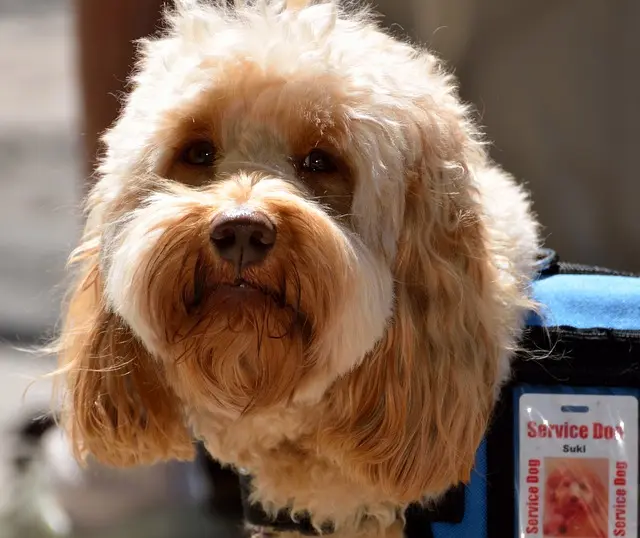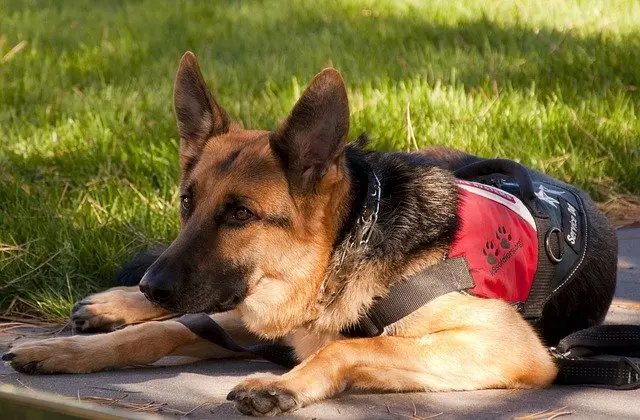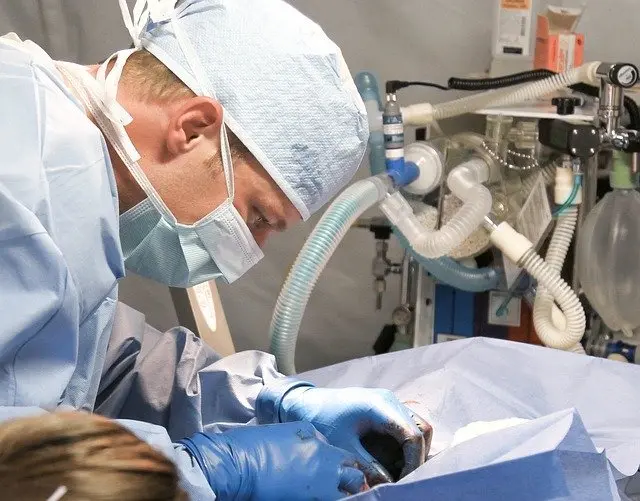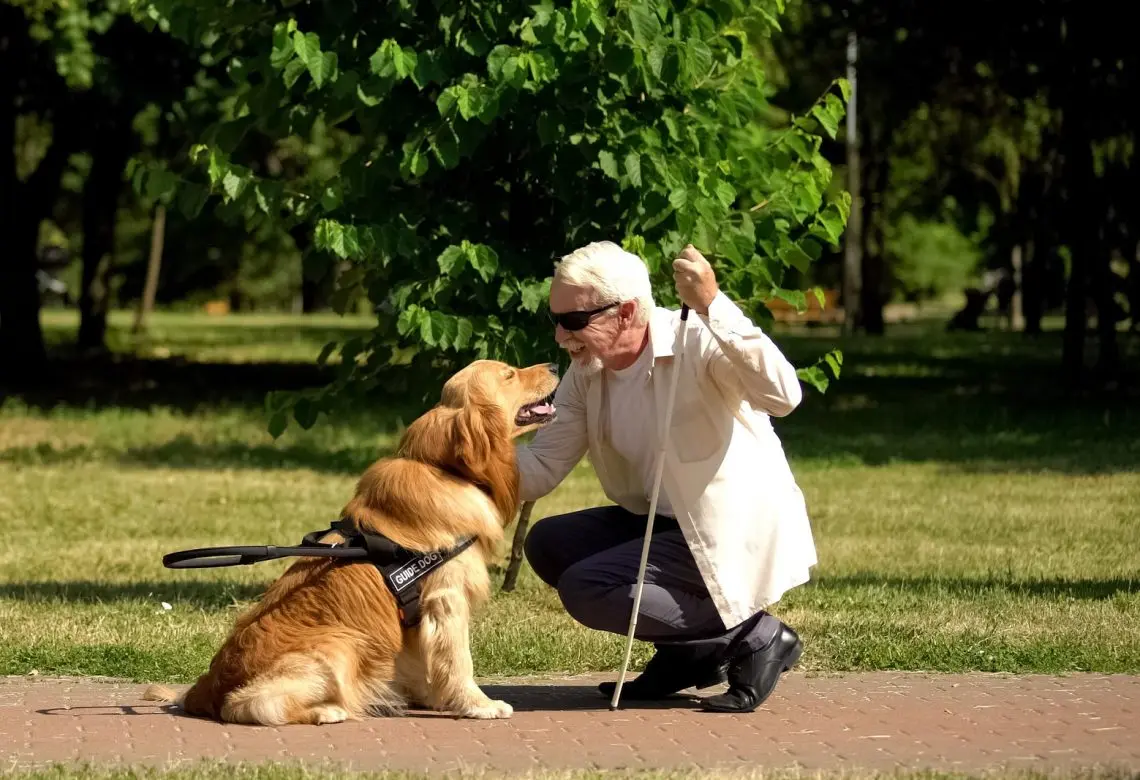For a dog with an essential role as a service dog, is neutering the best option? Many of us remember hearing episodes of The Price Is Right ending with “This is Bob Barker reminding you to help control the pet population – have your pets spayed or neutered.” However, recent studies show that rendering pets incapable of reproduction is not without drawbacks.
While many organizations require service dogs to be spayed or neutered, it is not required by the Americans With Disabilities Act (ADA). Therefore, it is up to the owner to decide if they want to have the procedure done on their dog. There are many positives to spaying or neutering your service dog, and only a few negatives.
You may not have a choice in the matter. If your service dog comes from a shelter, the decision to spay or neuter has probably already been made for you. Likewise, most organizations that provide fully-trained service dogs to people have them altered before matching them with their new owners. But, if you purchase a puppy on your own to train as your service dog, this is a decision you will have to make. We are going to look at the positives and negatives of altering your service dog.
Table of Contents
What is a service dog?
According to the ADA, “A service animal is a dog that is individually trained to do work or perform tasks for a person with a disability.” These tasks must be directly related to the person’s disability to qualify the dog as a service dog. Unfortunately, there is a rising problem in the US with “fake service dogs.”
The ADA does not require a service dog to be professionally trained and requires no certification or testing of service dogs. That has opened the door to dishonest people who wish to take their pets places that do not usually allow dogs or to avoid fees associated with their pets. Thankfully, many states have added laws pertaining to misrepresenting a service dog. As of 2019, 23 states had penalties for this. The punishment varies from state to state, with California being the most severe. They have a penalty of up to six months in jail or a fine up to $1000, or both.
General Benefits to Spaying/Neutering
- No unwanted litters. While this is the most advertised reason by animal rights groups and shelters, it is not the strongest argument for altering your dog. If your unaltered dog is not allowed to mate with another unaltered dog, there will be no puppies. It is as simple as that. Spaying or neutering is not required to prevent puppies, careful management of your dog is required! A service dog must be under the constant control of its handler when in public, so if the owner is also conscientious of the dog at home, the chance of puppies is slim to none.
- Males are less distracted by bitches in season. While it is possible to train a dog to ignore the distraction of a nearby bitch in heat, it is not an easy task. A service dog always needs to be focused on its handler when working, and fighting against another natural instinct to keep that focus is a challenge that can be alleviated by neutering.
- Females will not come into season. The average age that a bitch has her first heat cycle is six months, but that is only an average and varies from dog to dog. Most bitches have a heat cycle twice per year (again, that can vary between breeds and individual dogs) lasting an approximate 8-21 days each time. Although there are not any medical reasons that a service dog could not work during her heat cycle, there are a few other reasons it should be avoided. First off, a heat cycle is messy. Frequently, bitches will urinate more often as they are coming into season and throughout their cycle. This urine marking is hugely distracting to intact male dogs, and even to some neutered males. There is also discharge throughout most of her cycle. If you were to take your service dog to public places while she was in season, the polite thing to do would be to put her in some sort of dog diaper. But you will need to remove them each time you want to allow her to relieve herself.
- Prevent mood swings and behavioral changes in females. Many times, the hormonal changes that a bitch experiences before, during, and after her heat cycle can cause some extreme behavioral changes. These can include aggression toward people or other dogs, increased anxiety, or a tendency to be extremely affectionate or “clingy” toward their owner. None of these are conducive to a service dog’s ability to work.
- Allow your female service dog to work year-round. Because of the reasons mentioned above, a female service dog is likely to be unable to accompany her owner everywhere for several weeks each year. That is a considerable inconvenience for someone that relies on their service dog for daily assistance with routine outings and tasks.
- May reduce a tendency toward aggression. I say “may” because it will only help if the aggression is influenced by male hormones. In a study referenced by VCA Hospitals approximately 30% of the dogs showed reduced aggression to other dogs or people in their household. In comparison, the aggression only decreased by 20% toward unfamiliar dogs and 10% toward unfamiliar people.
- Reduce hormone influenced behavior problems in male dogs. While neutering will not change temperament, personality, or ability to work (those traits come from upbringing and genetics), it is likely to decrease a dog’s desire to roam. It also should help decrease mounting and masturbation.
- Reduce urine-marking. That is generally most noticeable in male dogs, but some females will urine mark as well. Spaying or neutering will not completely eliminate this behavior. In that same study referenced by VCA Hospitals, 80% of male dogs showed a moderate reduction of urine-marking after neutering, and 40% of them showed a substantial decrease. There is usually a higher chance of success in reducing urine-marking if the neuter is done when the dog is younger, and the behavior has not become a strong habit.
General Benefits of Leaving a Dog Intact
- Breeding ability. Your service dog may be a dog worthy of being bred. There are alternatives to keeping a male dog intact for this (such as collecting and freezing semen), but obviously, it is not possible to breed a female once she has been spayed.
- Showing in conformation shows. Your service dog must be intact if you wish to show them in an AKC conformation show. That is not a typical event for service dogs to participate in, but some people enjoy doing this as an activity with their dog, even if it is a working service dog.
- Heath benefits. That is controversial, as studies show health benefits and adversities to both altering and keeping intact, and the results of those studies are continually being updated. We will go through some of those later in this article. However, there is quite a bit of information now leading us to believe that it is beneficial to a dog’s health to at least postpone altering until the dog has reached sexual maturity.
Am I Required By Law To Spay or Neuter My Service Dog?
The short answer to this is no. The ADA Requirements put out by the US Department of Justice do not require service dogs to be spayed or neutered. However, many organizations that provide trained services dogs or teach owners to train their own service dogs do require the dogs to be sterilized.

Assistance Dogs International is a worldwide coalition of non-profit programs that train and place service dogs with individuals with disabilities. They are considered to be the leading authority in the Assistance Dogs industry. Any organization that wishes to have ADI affiliation must adhere to a list of ADI Standards, and one of those requires that all dogs must be spayed or neutered prior to placement. They also require that any dog that is placed in a home due to a career change (when a dog is unable to complete the requirements to become a working service dog) or retirement be spayed or neutered before placement. That is required even if the dog being retired was one that was previously used only as breeding stock in the program. If an ADI program works with owners training their personal dogs to be service dogs, they must require the owner to spay or neuter the dog before starting their training program.
There are many other service dog training programs throughout the United States that are not a part of ADI, and it is up to the individual program to set their guidelines regarding spaying and neutering. If you choose to go through one of these programs, you would be required to follow their protocol. However, the ADA clearly states that “People with disabilities have the right to train the dog themselves and are not required to use a professional service dog training program.”
Difficulties With Having An Intact Service Dog
Keeping your service dog intact can be a challenge for many people. The biggest problem with an intact male is generally keeping their focus. It can be challenging to train an intact male to ignore a nearby female in season. While not impossible, it takes a lot of practice to override their natural desire for mating – and many people do not put in the time needed to accomplish this.
Service dogs spend a lot of time in areas that other dogs are not allowed, so they often do not encounter bitches in season. Because of this, you will need to make sure that you set up many practice situations involving other dogs, especially ones in heat. Without practice (often called “proofing” in dog training), your dog may be very difficult to control should they be in an area with female dogs, especially where the female dogs have urinated.
Intact males are also more likely to “mark their territory.” Again, this is something that can be controlled with strict training. However, it is usually more prominent in unneutered male dogs and will require a vigilant owner to make sure your dog does not lift his leg inappropriately when out in public. Female dogs do not usually mark as much as male dogs, but it is not unheard of. Especially when coming into season and during their heat cycle, many female dogs will urinate more often and in inappropriate places to alert male dogs to their presence.

Dog aggression is usually more common in intact animals. Males often feel the need to challenge other male dogs, especially if there are bitches nearby and even more so if there is a one in season. Bitches in season can also be more aggressive than spayed females. Some will tend to become less tolerant of other females during their cycle, and they are especially grouchy with male dogs, except during the few days they are receptive to breeding.
If you choose to keep your female service dog intact, it will be difficult to keep her performing her work during the weeks that she is in estrus. The hormonal changes she will experience may cause a change in behavior that could be difficult to deal with. Some bitches become more aggressive, but others become more fearful or even more needy – these behavioral changes can be detrimental to service work. Besides behavioral challenges, you will need to keep your bitch in panties while in public places to avoid any discharge being left behind. These panties will need to be removed each time you take her to potty and then immediately put back on.
Keep in mind that if you are keeping your bitch intact to breed her, she will not only be unable to work during her estrus cycles; she will also need to take approximately four months off to whelp and raise the puppies. If you genuinely need a service dog to assist you with your daily routine, you can see what a huge inconvenience an intact bitch would be. The only real solution to this problem would be to have a second trained service dog that could work on the days when your bitch would need to stay home.
Is Spaying or Neutering Better For My Service Dog’s Health?
For many years, veterinarians recommended neutering or spaying your dog as soon as they turned six months old. Owners were told that in addition to preventing unwanted litters and behavior problems such as urine marking and aggression, it provided many health benefits to your dog. These health benefits include removing the risk of pyometra (a life-threatening uterus infection), significantly reducing the chance of uterine, ovarian, and mammary cancer in bitches, eliminating the risk of testicular cancer in males and reducing the chance of non-cancerous prostate disorders and perianal fistulas.

While these benefits still exist, recent studies have shown that spaying or neutering, especially before the dog has reached sexual maturity can also have adverse effects on your dog’s health. Spaying or neutering significantly increases the chance of osteosarcoma (bone cancer) in both dogs and bitches – especially if done before one year old in males and 2.5 years old in bitches. Hemangiosarcoma is also more prevalent in spayed and neutered dogs. Other adverse effects seen more often in spayed or neutered dogs include hypothyroidism, orthopedic disorders, adverse reactions to vaccines, urinary tract infections (in females), and urinary tract cancers (in males).
If you are working with a service dog organization that requires spaying or neutering, you do not really have a choice. You must have your dog spayed or neutered. However, you do have a decision when it comes to the age of your dog when you decide to have the procedure done. Consider waiting until your dog is mature enough to spay or neuter it to achieve the most benefits and least adverse effects. Hormones released at puberty help close the epiphyseal plates on the long bones in your dog. If this is not allowed to occur, it can create a variety of orthopedic problems, including hip dysplasia, cranial cruciate rupture, and patellar luxation, all of which are detrimental to a service dog’s career.
It takes many months, if not years, to train a service dog. An option would be to begin the training on your own or with a private organization without spay or neuter regulations when your dog is a puppy. Once your dog has reached adulthood, you can spay or neuter and then continue with any of the organizations that require sterilization.
In the case of a service dog, the benefits of spaying and neutering are great. However, a focused, easy to train dog that requires no time off for estrus or puppies is useless if they have crippling orthopedic issues or develop cancer at an early age. Elective surgery on any dog will have risks as well as benefits. It is crucial that you weigh the pros and cons carefully before deciding to spay or neuter your service dog. I suspect that you will find the pros outweigh the cons, so long as you wait for your dog to reach maturity before having the procedure done.




